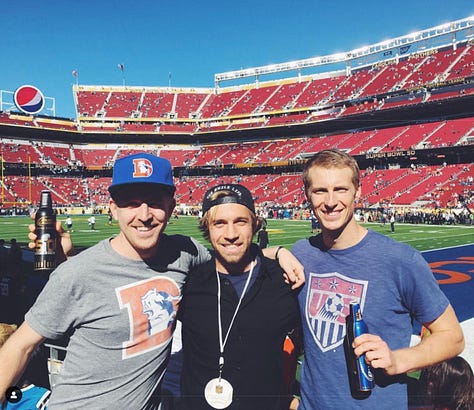The life-changing magic of a uniform
On sneaking into the Super Bowl and cosplaying the life you want
When I was a teenager, I couldn’t get tickets to a sold out John Mayer concert, so I went anyway and I slipped in through the backdoor. This is how I discovered my unusual aptitude for entering ticketed events without tickets. It led to a summer spree of compulsive gatecrashing, which escalated into my college years. I became very good at disappearing into crowds and past security checkpoints, but I wanted to taste greatness. I set my sights on bigger and bigger events, eventually on the best seats at the biggest events in the world, but it became increasingly difficult to remain calm, cool, and collected in the face of extreme consequences and security measures. So I looked to a uniform for help.
I didn’t look to the uniform for its camouflaging effect, what I needed was a mindset shift. It’s well understood that uniforms shape outward perception, establish identity, and convey authority. But they’re underestimated as a tool for signaling these things to ourselves.
Innumerable studies confirm that a uniform doesn’t merely make you look or feel a certain way, it actually makes you become a different person. A uniform wearer literally changes to become more of whatever they need to be: more confident, more capable, more intelligent, more decisive and disciplined, more self-assured, more attractive.1 The humble uniform makes good on the promise of an entire library of self-help books.
I needed nerves of steel, but many preoccupations (like gatecrashing), don’t issue uniforms. Oftentimes when you need one, you must invent it yourself.
I learned this from Tiger Woods. He wanted to be the greatest golfer who ever lived, and he trained with incomparable intensity. But he gave himself an extra edge by inventing a persona and dressing it in a red performance polo and black pants on Sundays, for the final round of every golf tournament he competed in. Tiger Woods in red became mythological. It signaled inevitability — intimidation, power, aggression. Phil Michelson, his frequent rival, once said: “I tried to avoid looking at Tiger on Sundays” because it felt like a predator was circling. In red, he became who he set out to be.2
This is not an isolated example. Steve Jobs wore a black Issey Miyake turtleneck and New Balance 992’s and the world saw a visionary creative genius. Anna Wintour is impenetrable in her Chanel sunglasses, with her signature bob and a floral midi dress. Mr. Rodgers changed into a zip-up cardigan each time he entered The Neighborhood — creating a division between the unpredictable outside world, and the sanctuary he invited his viewers into.3 I’m sure you can think of others. If the patterns of historical figures reveal anything about uniforms, there is a lot to gain from inventing one and wearing it.
At least that was my takeaway. So with my sights set on the most heavily fortified stadiums in the world, I invented a uniform to unlock consistent composure, confidence, and clarity of mind. I opened my wardrobe, picked out a black button-down dress shirt and I said to myself: “They’ll never catch you in this.” I called it my ‘gatecrashing uniform.’
In the years that followed I worked my way up from the minors to the big leagues, eventually wearing my gatecrashing uniform for ticketless entry to the Super Bowl, the NBA Finals (3x), the World Series (4x), March Madness (3x), Coachella (4x), Mayweather vs McGregor, and a long, long list of other highly-secure events and VIP parties. In my uniform, I acted like I belonged in front row seats, owner’s boxes, exclusive cabanas, media booths, artists lounges, fifty yard lines, and all-you-can-eat sections. I watched from onstage as Drake headlined ACL in front of 75,000 people. I joined Neymar, Lewis Hamilton, and Jamie Foxx in box seats at the Rose Bowl. My now-retired gatecrashing uniform has graced many seats worth tens of thousands of dollars — and many seats that are priceless.



I didn’t suddenly possess an invisibility cloak and I don’t want to give the impression that the Uniform Effect happens immediately. But as I continued wearing the uniform and developing a history with it, my identity shifted on the rare occasions when I put it on — not totally unlike the supersuited and pedestrian versions of Clark Kent. Whenever I wore it I told myself a story: that I was unflappable, self-assured, affable, highly risk-tolerant. Eventually the shirt told the story back to me. I buttoned it up and entered a flow state, mastered the esoteric art of crowd movement, and developed a sixth sense for surveillance. All things I couldn’t do and wouldn’t dream of trying to do in a t-shirt.
My black gatecrashing uniform had inconspicuous and stealthy undertones — but not enough to bridge the gap between sneaking into a regional John Mayer show and the most highly-surveilled event classification in the world, Super Bowl XL. The difference was in the person I became while wearing my uniform. Like Tiger in Sunday red, I found an extra edge and channeled dormant potential through powers of the imagination. The strength of a uniform accrues in compounding gestures — you do the thing you said you were going to do, until you can’t help doing it.
The great news about an invented uniform is that you don’t need permission to wear one. You don’t need to become a postal worker, a sergeant, or a pilot. You don’t need a specific job title. You don’t even need a job.
You simply start with an aspiration or intention, then you find an article of clothing (or a whole outfit) — something you can commit to wearing whenever you want to emphasize that intention — and you tell yourself a story about it. Who are you when you wear it? What are your expectations of yourself? What are the ground rules for wearing it? Are you allowed to wear it when you’re not in uniform-mode? Be specific, write the rules down. Don’t forget them. Make it easy to reach for the uniform when you need it. Give it a name. Make a wholehearted commitment to consistency. At the fragile, early stage of your development, tell yourself: “I don’t have to be consistent in every area of my life, just this one.” Don’t be afraid to tell others about your uniform. Be playful about it. Start small.
Your metamorphosis has begun, but you’ll need to get comfortable with cosplay. You can assign magical qualities to a hat or a shirt or anything you like, but in order to transform it into something mythological you must suspend disbelief, be imaginative, and consistently live in the story.
Eventually you’ll reach the identity formation stage of the Uniform Effect, when the psychological powers of commitment and consistency kick in and you become a different person in your uniform. This is a special stage: the article of clothing takes on a great deal of personal meaning and it becomes a force multiplier for your original intention.4 This takes time. Tiger Woods first wore his red shirt in a professional tournament at age twenty — and I’m sure it took a few years for other golfers to remember the color, let crumble at the sight of it. Like everything that becomes worth anything, it takes time.
You can invent a uniform for anything. Want to be a better partner? A better listener? Give listening glasses a try. Afraid of reaching out to strangers? Wear cold-calling pants until it gets easier. It will get easier. Nervous about pitching investors? Create a sharp, top-to-bottom fundraising outfit, and practice relentlessly in it. Too self-conscious to dance? Buy yourself dancing shoes, tell yourself a story about them. Start dancing in them privately. An oversized hoodie might be just the thing you need for intense focus and deep work sessions. Try a wristband for a fitness goal.
Of all of the tricks I’ve played on myself over the years to motivate follow-through and stimulate ‘self-actualization’ — the uniform has surprised me the most. It still surprises me. It’s like taking a placebo and knowing it’s a placebo. It really doesn’t seem like it should work so well. The gatecrashing uniform isn’t my only rodeo; I also have an “adventure uniform” — a green hat, something between dad and trucker, with a patch on the front that says “Keep Life Wild.” While wearing it, I’ve summoned the courage to hitchhike across three continents, among countless other adventures. Now it feels like I’m wearing a cape when I put it on.
More relatably, I’m in the process of establishing a new uniform: “a writing uniform.” For years, I’ve aspired to develop a regular writing and publishing habit. I’ve tried to cajole myself into writing consistently by paying an eye-watering amount for a writing bootcamp, and by turning to friends for high stakes accountability. Every year, a writing goal sits high on my list of yearly intentions. Every year, no dice. This long-standing goal remained undefeated and seemingly insurmountable until recently. Recently I found hope in a hat that I could comfortably wear under noise cancelling headphones. I made a writing uniform out of it; I said to myself: “When you wear this, you’re a writer. And writers write.” Over the past two months, I’ve risen early every morning, put on my hat and written for an hour, sometimes two, before removing it and beginning my other work. Without fail. The first week was harder than the second week, and so forth, but now it’s starting to feel like a dereliction of duty not to write.
Your closet is full of untapped magic. You can put it to work and become whoever you want. If you dress up and play pretend for long enough, one day you’ll look up and realize you’re no longer pretending.
A few example studies:
Enclothed cognition, 2012: participants wearing a “doctor’s coat” made half the errors on selective attention tests, compared to people wearing casual clothes. (link)
The Cognitive Consequences of Formal Clothing, 2015: people wearing business/formal attire performed better on cognitive tasks (more abstract thinking, broader category inclusion) than those in casual clothing. (link)
Johnson & Downing, 1979: participants wearing KKK-style robes administered harsher “electric” shocks than those wearing nurse uniforms (with no change in instruction). (link)
Tiger Woods recently ended his 27-year sponsorship with Nike to start his own brand. He called it Sun Day Red.
His mother hand-knitted his cardigans!
Whenever I’ve encountered the question: “What’s in your go-bag?” I don’t think of expensive things, I think immediately of the clothing I’ve invented into uniforms.





I was just relating the story to family last night, of our mutual affinity for John Mayer, especially “The Heart of Life,” then while sitting in a Land Rover in the Masai Mara, watching the animals, my phone vibrates, and it was you, at a John Mayer concert, listening to “Heart of Life.” One of my favorite moments!